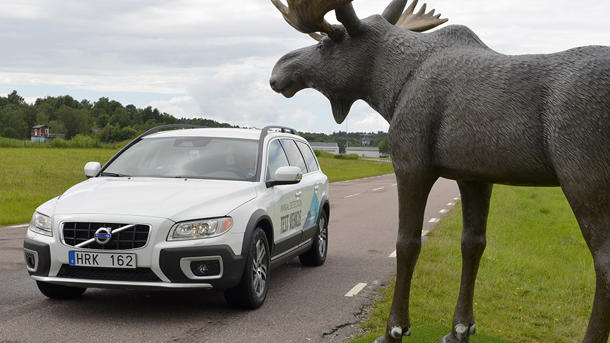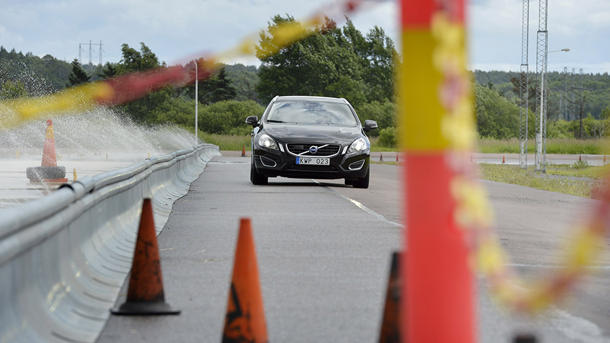For decades, Volvo has made improving auto safety a foundation of its business — a move that made it famous for a few decades, but did little to help the Swedish manufacturer so far this century. Now that it's purchase by a Chinese auto conglomerate has had a few years to settle, Volvo has begun to make another push for greater safety on the road. Its goal: To eliminate the risks of death or injury to Volvo passengers by 2020, a tight deadline in auto engineering circles. From my visit to Volvo headquarters in Gothenburg, Sweden, I've now seen the technology that Volvo says can meet that goal. The question is how it will put it on the road.
Pedestrian Detection in Darkness
In 2006, Volvo introduced pedestrian detection to help the driver slow the car before an impending collision. Since then, more features were added in 2010 with auto braking, and in 2013 cyclist detection. Next year, the Swedish automaker is extending pedestrian detection capabilities to darkness. This added capability is important for the Scandinavian country because 58 percent of all pedestrian fatalities occur at night, at dusk or dawn, according to STRADA (Swedish Traffic Accident Data Acquisition). And based on data from VTI (Swedish National Road and Transport Research Institute), the traffic fatality rate in the United States is three to four times higher in the darkness as well.
Inside what use to be an underground military bunker, we test drove a vehicle equipped with higher sensitivity cameras. Heading toward a human-shaped obstacle in complete darkness except for the headlights, we were told to maintain 16-mph speed, ignore the audio and visual warnings and not touch the brakes. As we got closer and about to stab the brakes ourselves, the car reacted quickly and stopped the car before we collided with the mannequin. Barely.
Animal Detection
Whether it's moose in Sweden or deer in the United States, thousands of drivers know the dangers of striking an animal at speed. The forces and impact experienced from hitting a moose at 62 mph is like dropping a 1,000-lb weight from the top of a ten-story building. Volvo has determined that any collision with speeds over 43 mph is 70 percent more likely to cause severe injuries. So the goal is to detect the animals early — during daylight or at night — and allow the car enough time to slow itself automatically below the 43 mph threshold, either to avoid the collision completely with steering input by the driver, or lessen the impact and injuries to the occupants if collision is unavoidable. On a test rack onboard the demonstration vehicle traveling 55 mph, a moose dummy a good distance away on the side of the road was detected quickly, allowing enough time for emergency maneuvers.
Steering Assist for Adaptive Cruise Control and Road Edge/Barrier Detection
While adaptive cruise control comes standard on many premium car models, Volvo is incorporating steering assist into the technology, in particular to help lane-keeping as drivers may be less attentive below 18 mph during stop-and-go traffic situations. Additionally, steering assist has also been added to road edge and barrier detection at higher speeds around 43 mph to prevent vehicles from drifting off pavement. During our test drive of both technologies, the car was able steer back in the lane without human input, but the execution was done progressively to not surprise the driver. In both cases, driver intervention will always override the steer assist feature.
According to the National Highway Transportation Safety Administration, half of all traffic fatalities are road departure accidents. Thomas Broberg, senior safety advisor for Volvo, noted: “Being able to monitor where the physical road ends is a world’s first. This means that the technology also works on roads without side markings.”
Car 2 Car Communication
Have you ever wondered why traffic sometimes slows suddenly to a crawl and then speeds up again with no apparent reason? That’s because of the accordion effect where something had happened to cause the initial slowing, but none of the cars behind knew about it up until the location of the slow-down, thus propagating the effect rearward. To mitigate situations like this, car-to-car communication technology was demonstrated by Volvo enabling the vehicle behind to be warned of such adverse conditions ahead.
The concept of making cars smarter and be able to talk to each other also extends to car-to-infrastructure communication, where you’ll be able to see the timing of upcoming red lights, or traffic congestion so you can be advised to adjust your speed appropriately to prevent unnecessary accordion effects — a much smarter live traffic information than we get now.
Where do all these technologies take us?
It is very apparent that all the technologies demonstrated by Volvo can all be potentially combined together in the future for fully an autonomous vehicle, another system Volvo has experimented with. But even Volvo admits that the world isn't prepared for a 100 percent autonomous car. The current technology is not yet equipped to process or react to all the possible dangerous scenarios encountered on the road as quickly as the human brain.
The company goal is to progressively add on features to enhance and assist driver safety, but at the same time always have the driver make the final call. Judging on all the technologies that Volvo demonstrated, with several of them already making into production next year on the upcoming all-new XC90, the company’s vision to have no one killed or seriously injured by 2020 in a new Volvo doesn’t seem that far fetched after all.
Source: Yahoo!


No comments:
Post a Comment